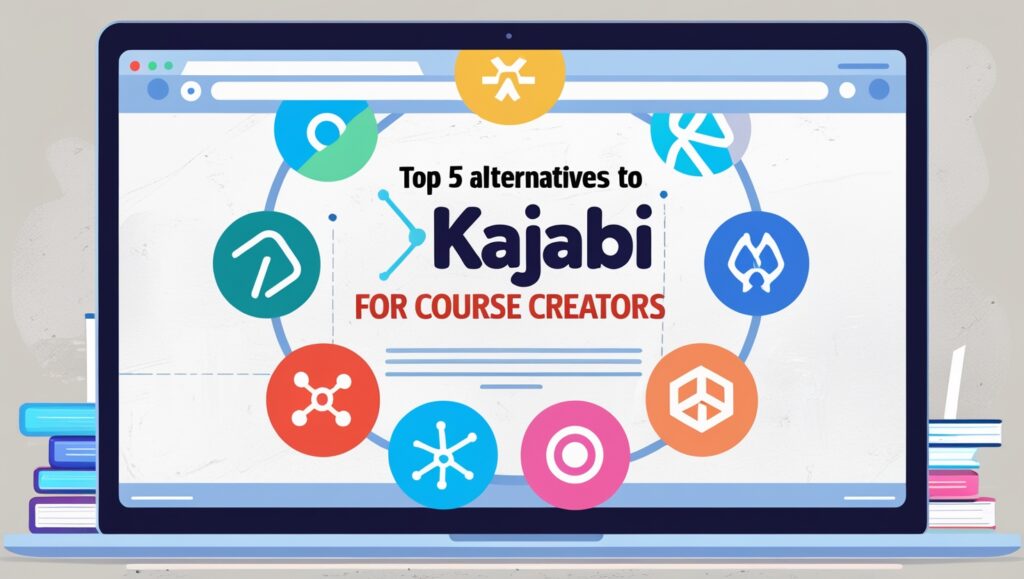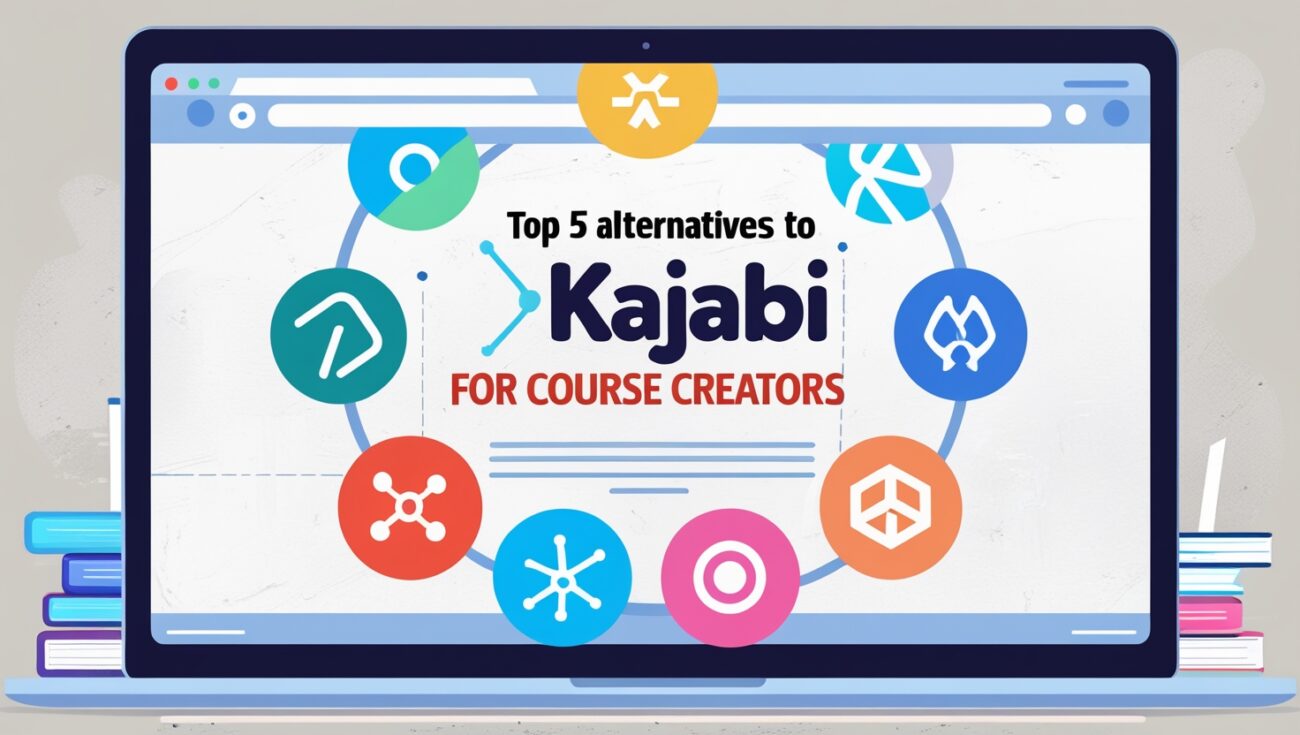Top 5 Alternatives to Kajabi for Course Creators
If you’re anything like me, you’ve probably tried or at least looked into Kajabi. It’s popular, it’s sleek, and it seems like everyone is using it. But once I got past the hype and actually used it, I realized something — Kajabi isn’t for everyone, especially if you’re just starting out or want something more community-driven.
I’ve tested a lot of platforms in my journey as a course creator. Some were overly complex. Some were overpriced. And a few were actually great. So if you’re looking for Kajabi alternatives for courses, this list is for you.
Let me break down the top 5 tools I’ve personally used (or researched deeply), and what makes each one unique.

Table of Contents
1. Skool (My #1 Pick)
After bouncing around multiple platforms, Skool became my go-to. It’s the one I personally use to host my paid community and course materials. What sets it apart is how simple and engaging it is.
Skool combines:
- A private community
- A clean course area
- Event calendar
- Built-in gamification
- Payment integration via Stripe
You don’t need a website, a funnel, or a tech team. I built my group in a day, and people started joining fast.
If you want to start simple and scale as you grow, this is your best option.
2. Thinkific
Thinkific is a solid Kajabi alternative if your main focus is course structure and customization. It allows for detailed course building, quizzes, assignments, and more.
What I liked about it:
- Clean user experience
- Free plan to test it out
- Great for academic-style or professional courses
Where it lacks: there’s no built-in community feature, so if you want engagement, you’ll need to integrate third-party tools.
3. Podia
Podia is great for creators who want simplicity with storefront vibes. You can sell courses, digital downloads, webinars, and coaching, all under one roof.
What I enjoyed:
- Very beginner-friendly
- Built-in email marketing
- Solid checkout process
But the community and course features aren’t as robust as Skool, especially if you want deep student interaction.
4. Circle
If community is your top priority and you like flexibility, Circle is worth considering. It gives you tools to build a branded space where members can interact and access resources.
Why I tested it:
- Beautiful interface
- Full customization
- Native member profiles and notifications
But I found it required more setup time, and didn’t feel as intuitive as Skool. It’s better if you’re more advanced or have a team.
5. Teachable
Teachable is one of the OG platforms, and it still holds its ground today. It’s perfect if you want to focus purely on course content and delivery without the bells and whistles.
What stands out:
- Easy to build courses
- Supports coaching and bundles
- Decent analytics and affiliate tracking
But like Thinkific, it lacks a built-in community. So your audience might finish the course and never return.
Why I Ultimately Chose Skool
At the end of the day, I wanted one tool that could handle:
- Courses
- Community
- Payments
- Live events
- Engagement without extra apps
And Skool checked all those boxes. It simplified everything and saved me time, stress, and money. Plus, the vibe inside the community is better than anything I’ve experienced on Kajabi.
If you’re serious about creating a community that grows and pays you monthly — without needing a funnel — Skool is the move.
Try Skool here and thank me later.
One of the biggest reasons I moved away from Kajabi was the overwhelming cost. While it’s an all-in-one platform, the truth is that most creators — especially those just starting — don’t need everything it offers. I was paying over $100/month for features I never used. With Skool, I pay one flat fee and get everything I actually need.
I also noticed that student engagement was dropping on Kajabi. People would log in for the course and never return. That’s a problem if you’re trying to build a community or get recurring revenue. What I needed was something that encouraged daily interaction — not just one-time access. Skool fixed that for me with its built-in community feed and leaderboard.
Another thing Kajabi lacked for me was simplicity. Their interface is modern, but navigating all the tabs — products, pipelines, automations, pages, offers, etc. — felt like I needed a certification just to launch. Skool, on the other hand, took me less than an hour to fully set up. No joke — my course, community, and payment system were ready to go in one afternoon.
Podia and Thinkific are decent, but they still follow the old “course-first, community-second” model. That might work for people who sell static content, but I realized that I wanted to build something more alive — a space where people come back, ask questions, and network. Skool naturally builds that kind of ecosystem.
I’ve also seen that using fewer tools = fewer tech headaches. Before switching, I had to connect Kajabi with Stripe, ConvertKit, Zoom, Zapier, and Google Calendar. Something always broke. With Skool, I use the built-in calendar for my group calls, Stripe for payments, and everything else happens inside one platform.
From an SEO and discovery standpoint, having a public-facing group page on Skool helped me too. I can share that link across my blog, socials, or emails and people can immediately understand what they’re joining. No need to build out a landing page or design a funnel. That page alone replaced three tools I used to pay for.
Let’s talk retention. Kajabi was a good course host, but once people finished the material, they left. Skool solved that because people stay for the community conversations, not just the content. That’s key if you want recurring income. I no longer have to constantly launch new things to keep revenue steady.
If you’re a coach or consultant, Skool works extremely well for group programs. You can create a course, schedule live Zoom calls in the calendar, and manage all your members in one place. I used to do all this with five tools — now I do it with one.
As for customer support? Skool has a community support group where creators like me get answers, tips, and updates from the team. Kajabi has support too, but I found it slower and not as transparent. The Skool team is active and actually listens to users.
Also, I didn’t expect the gamification feature to matter much — but it absolutely does. Members earn points for participating, which drives more engagement. I’ve seen people go from lurkers to leaders in my group just because they wanted to hit the leaderboard. That level of organic motivation helps my group thrive without me having to push it all the time.
When I promote Skool, I don’t do it just for affiliate commissions — I do it because I genuinely believe it’s a better tool for modern creators. The fact that I also earn monthly affiliate income from it is a bonus. If you’re planning to switch or start from scratch, do yourself a favor and skip the funnel circus.
Here’s my Skool affiliate link again — this is the same platform that helped me finally simplify and scale my online community without all the moving parts.






